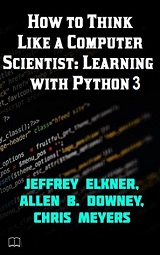
|
FreeComputerBooks.com
Links to Free Computer, Mathematics, Technical Books all over the World
|
|
- Title How to Think Like a Computer Scientist: Learning with Python 3 Documentation
- Author(s) Allen B. Downey, Jeffrey Elkner, Peter Wentworth, and Chris Meyers
- Publisher: Green Tea Press (2002); eBook (GNU Edition, ReadTheDocs.org, Apr 17, 2020)
- License(s): GNU Free Documentation License
- Paperback 288 pages
- eBook HTML, PDF (384 pages), and PostScript
- Language: English
- ISBN-10: 0971677506
- ISBN-13: 978-0971677500
- Share This:

|
This book is an introduction to computer science using the Python programming language. It covers the basics of computer programming, including variables and values, functions, conditionals and control flow, program development and debugging. Later chapters cover basic algorithms and data structures.
Through exercises in each chapter, you’ll try out programming concepts as you learn them. This book is ideal for students at the high school or college level, as well as self-learners, home-schooled students, and professionals who need to learn programming basics. Beginners just getting their feet wet will learn how to start with Python in a browser.
About the Authors-
Allen Downey is an Associate Professor of Computer Science at the Olin College of Engineering. He has taught computer science at Wellesley College, Colby College and U.C. Berkeley. He has a Ph.D. in Computer Science from U.C. Berkeley and Master's and Bachelor's degrees from MIT.
He has written several books, including Computational Modeling and Complexity Science, How to Think Like a Computer Scientist, The Little Book of Semaphores, Physical Modeling in MATLAB, and Learning Perl the Hard Way.
- Python Programming
- Data Structures and Algorithms
- Introduction to Computer Science
- Books by Allen B. Downey

- How to Think Like a Computer Scientist: Learning with Python 3 Documentation
- The Mirror Site (0) - HTML
- The Mirror Site (1) - PDF
- The Mirror Site (2) - HTML, PDF, Postscript, LaTeX
- Book Homepage (HTML, PDF Download, etc.)
-
 Learn Python the Right Way: Think like a Computer Scientist
Learn Python the Right Way: Think like a Computer Scientist
The goal of this book is to teach you to think like a computer scientist. This way of thinking combines some of the best features of mathematics, engineering, and natural science.
-
 Python for Everybody: Exploring Data in Python 3
Python for Everybody: Exploring Data in Python 3
This book is designed to introduce students to programming and software development through the lens of exploring data. You can think of the Python programming language as your tool to solve data problems that are beyond the capability of a spreadsheet.
-
 Automate the Boring Stuff with Python (Albert Sweigart)
Automate the Boring Stuff with Python (Albert Sweigart)
Learn how to use Python to write programs that do in minutes what would take you hours to do by hand - no prior programming experience required. You'll create Python programs that effortlessly perform useful and impressive feats of automation.
-
 Problem Solving with Algorithms/Data Structures using Python
Problem Solving with Algorithms/Data Structures using Python
This is a textbook about computer science. It is also about Python. However, there is much more. The tools and techniques that you learn here will be applied over and over as you continue your study of computer science.
-
 Fundamentals of Python Programming (Richard L. Halterman)
Fundamentals of Python Programming (Richard L. Halterman)
It focuses on introducing programming techniques and developing good habits. To that end, our approach avoids some of the more esoteric features of Python and concentrates on the programming basics that transfer directly to other imperative programming.
-
 O'Reilly® Think Python, 2nd Edition (Allen B. Downey)
O'Reilly® Think Python, 2nd Edition (Allen B. Downey)
This hands-on guide takes you through the Python programming language a step at a time, beginning with basic programming concepts before moving on to functions, recursion, data structures, and object-oriented design. 2nd edition updated for Python 3.
-
 Functional Programming in Python (David Mertz)
Functional Programming in Python (David Mertz)
It describes ways to avoid Python’s imperative-style flow control, the nuances of callable functions, how to work lazily with iterators, and the use of higher-order functions. He also lists several third-party Python libraries useful for functional programming.
-
 Python 3 Patterns, Recipes and Idioms (Bruce Eckel, et al)
Python 3 Patterns, Recipes and Idioms (Bruce Eckel, et al)
This book is aimed at more experienced Python programmers who are looking to deepen their understanding of the language and modern programming idioms. It focuses on some of the more advanced techniques used by libraries, frameworks, and applications.
-
 O'Reilly® Python Data Science Handbook: Essential Tools
O'Reilly® Python Data Science Handbook: Essential Tools
Several resources exist for individual pieces of this data science stack, but only with the Python Data Science Handbook do you get them all - IPython, NumPy, Pandas, Matplotlib, Scikit-Learn, and other related tools.
-
 Modeling and Simulation in Python (Allen B. Downey)
Modeling and Simulation in Python (Allen B. Downey)
This book is an introduction to physical modeling using a computational approach with Python. You will learn how to use Python to accomplish many common scientific computing tasks: importing, exporting, and visualizing data; numerical analysis; etc.
-
 Introduction to Scientific Programming with Python
Introduction to Scientific Programming with Python
This book offers an initial introduction to programming for scientific and computational applications using the Python programming language. The presentation style is compact and example-based, assuming little or no prior experience in programming.
-
 Programming for Computations - Python 3 Edition
Programming for Computations - Python 3 Edition
This book outlines the shortest possible path from no previous experience with programming to a set of skills that allows students to write simple programs for solving common mathematical problems with numerical methods in the context.





